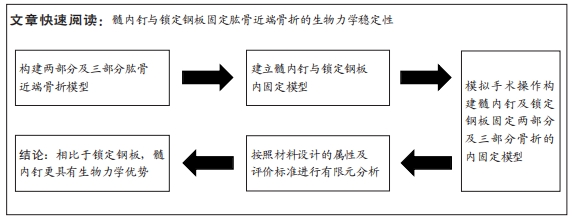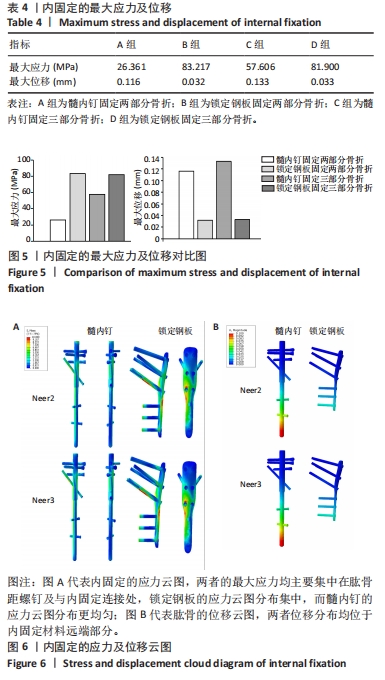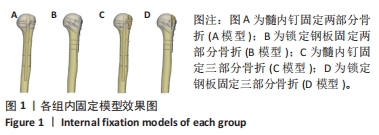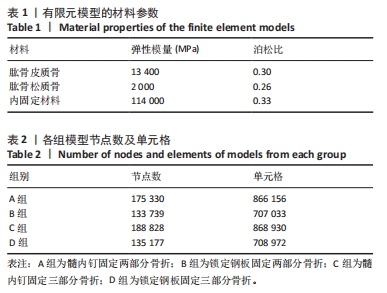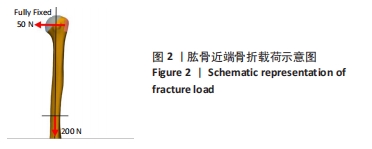[1] RYBICKI EF, SIMONEN FA, WEIS EB JR. On the mathematical analysis of stress in the human femur. J Biomech. 1972;5(2):203-215.
[2] LEINO OK, LEHTIMAKI KK, MAKELA K, et al. Proximal humeral fractures in Finland : trends in the incidence and methods of treatment between 1997 and 2019. Bone Joint J. 2022;104-B(1):150-156.
[3] NEER CS 2ND. Displaced proximal humeral fractures. I. Classification and evaluation. J Bone Joint Surg Am. 1970;52(6):1077-1089.
[4] VARGA P, INZANA J, FLETCHER J, et al. Cement augmentation of calcar screws may provide the greatest reduction in predicted screw cut-out risk for proximal humerus plating based on validated parametric computational modelling: Augmenting proximal humerus fracture plating. Bone Joint Res. 2020;9(9):534-542.
[5] LAUX C, GRUBHOFER F, WERNER C, et al. Current concepts in locking plate fixation of proximal humerus fractures. J Orthop Surg Res. 2017; 12(1):137.
[6] SUN Q, WU X, WANG L, et al. The plate fixation strategy of complex proximal humeral fractures. Int Orthop. 2020;44(9):1785-1795.
[7] GRACITELLI ME, MALAVOLTA EA, ASSUNCAO JH, et al. Locking intramedullary nails compared with locking plates for two- and three-part proximal humeral surgical neck fractures: a randomized controlled trial. J Shoulder Elbow Surg. 2016;25(5):695-703.
[8] BOYER P, COUFFIGNAL C, BAHMAN M, et al. Displaced three and four part proximal humeral fractures: prospective controlled randomized open-label two-arm study comparing intramedullary nailing and locking plate. Int Orthop. 2021;45(11):2917-2926.
[9] SHI X, LIU H, XING R, et al. Effect of intramedullary nail and locking plate in the treatment of proximal humerus fracture: an update systematic review and meta-analysis. J Orthop Surg Res. 2019;14(1):285.
[10] GUO Z, SANG L, MENG Q, et al. Comparison of surgical efficacy of locking plates and interlocking intramedullary nails in the treatment of proximal humerus fractures. J Orthop Surg Res. 2022;17(1):481.
[11] GRADL G, STEDTFELD HW, MORLOCK M, et al. Locking plate fixation of humeral head fractures with a telescoping screw. A comparative biomechanical study versus a standard plate. Injury. 2012;43(6):734-738.
[12] AL-JAHWARI A, SCHEMITSCH EH, WUNDER JS, et al. The biomechanical effect of torsion on humeral shaft repair techniques for completed pathological fractures. J Biomech Eng. 2012;134(2):024501.
[13] RODERER G, BRIANZA S, SCHIUMA D, et al. Mechanical assessment of local bone quality to predict failure of locked plating in a proximal humerus fracture model. Orthopedics. 2013;36(9):e1134-e1140.
[14] WIRTH AJ, MULLER R, VAN LENTHE GH. The discrete nature of trabecular bone microarchitecture affects implant stability. J Biomech. 2012;45(6):1060-1067.
[15] LIN F, YAO T, WANG C, et al. [FE modeling and analysis of the locking plate for proximal humerus fracture]. Zhongguo Yi Liao Qi Xie Za Zhi. 2013;37(2):84-87.
[16] MURDOCH AH, SHEPHERD DE, MATHIAS KJ, et al. Design of a retractable intramedullary nail for the humerus. Biomed Mater Eng, 2003;13(3):297-307.
[17] MALDONADO ZM, SEEBECK J, HELLER MO, et al. Straining of the intact and fractured proximal humerus under physiological-like loading. J Biomech. 2003;36(12):1865-1873.
[18] CLAVERT P, ZERAH M, KRIER J, et al. Finite element analysis of the strain distribution in the humeral head tubercles during abduction: comparison of young and osteoporotic bone. Surg Radiol Anat. 2006; 28(6):581-587.
[19] WIRTH AJ, GOLDHAHN J, FLAIG C, et al. Implant stability is affected by local bone microstructural quality. Bone. 2011;49(3):473-478.
[20] WIRTH AJ, MULLER R, VAN LENTHE GH. Augmentation of peri-implant bone improves implant stability: quantification using simulated bone loss. J Orthop Res. 2012;30(2):178-184.
[21] SCHLIEMANN B, SEIFERT R, THEISEN C, et al. PEEK versus titanium locking plates for proximal humerus fracture fixation: a comparative biomechanical study in two- and three-part fractures. Arch Orthop Trauma Surg. 2017;137(1):63-71.
[22] SCHLIEMANN B, SEIFERT R, ROSSLENBROICH SB, et al. Screw augmentation reduces motion at the bone-implant interface: a biomechanical study of locking plate fixation of proximal humeral fractures. J Shoulder Elbow Surg. 2015;24(12):1968-1973.
[23] RODERER G, SCOLA A, SCHMOLZ W, et al. Biomechanical in vitro assessment of screw augmentation in locked plating of proximal humerus fractures. Injury. 2013;44(10):1327-1332.
[24] LIANG D, YE LQ, JIANG XB, et al. Biomechanical effects of cement distribution in the fractured area on osteoporotic vertebral compression fractures: a three-dimensional finite element analysis. J Surg Res. 2015;195(1):246-256.
[25] HE Y, HE J, WANG F, et al. Application of Additional Medial Plate in Treatment of Proximal Humeral Fractures With Unstable Medial Column: A Finite Element Study and Clinical Practice. Medicine. 2015, 94(41):e1775.
[26] 何仿, 李苏皖, 林昊, 等. 间接暴力所致肱骨骨折机制的三维有限元模拟[J]. 中国矫形外科杂志,2008,16(8):613-616.
[27] MÜLLER F, DOBLINGER M, ECKSTEIN C, et al. The PHILOS plate-also an indication for osteosynthesis of the distal tibia?. Der Unfallchirurg. 2020;123(4):326-329.
[28] JIA Z, LI C, LIN J, et al. Clinical effect of using MultiLoc® nails to treat four-part proximal humeral fractures. J Int Med Res. 2020;48(12): 300060520979212.
[29] EDWARDS S, WILSON N, ZHANG L, et al. Two-part surgical neck fractures of the proximal part of the humerus. A biomechanical evaluation of two fixation techniques. J Bone Joint Surg Am. 2006; 88(10):2258-2264.
[30] FORURIA A, DE GRACIA M, LARSON D, et al. The pattern of the fracture and displacement of the fragments predict the outcome in proximal humeral fractures. J Bone Joint Surg Br. 2011;93(3):378-386.
[31] LILL H, HEPP P, KORNER J, et al. Proximal humeral fractures: how stiff should an implant be? A comparative mechanical study with new implants in human specimens. Arch Orthop Trauma Surg. 2003;123: 74-81.
[32] FÜCHTMEIER B, MAY R, HENTE R, et al. Proximal humerus fractures: a comparative biomechanical analysis of intra and extramedullary implants. Arch Orthop Trauma Surg. 2007;127(6):441-447.
[33] KITSON J, BOOTH G, DAY R. A biomechanical comparison of locking plate and locking nail implants used for fractures of the proximal humerus. J Shoulder Elbow Surg. 2007;16(3):362-366.
[34] YOON R, DZIADOSZ D, PORTER D, et al. A comprehensive update on current fixation options for two-part proximal humerus fractures: a biomechanical investigation. Injury. 2014;45(3):510-514.
[35] HESSMANN M, HANSEN W, KRUMMENAUER F, et al. Locked plate fixation and intramedullary nailing for proximal humerus fractures: a biomechanical evaluation. J Trauma. 2005;58(6):1194-1201.
[36] FLETCHER JWA, WINDOLF M, RICHARDS RG, et al. Importance of locking plate positioning in proximal humeral fractures as predicted by computer simulations. J Orthop Res. 2019;37(4):957-964.
[37] 冷昆鹏, 王艳华, 陈建海, 等. 肱骨近端三维有限元模型的建立与生物力学分析[J]. 中华创伤骨科杂志,2015,17(4):326-330.
[38] KIM H, LEE W, CHOI S, et al. Role of Additional Inferomedial Supporting Screws in Osteoporotic 3-Part Proximal Humerus Fracture: Finite Element Analysis. Geriatr Orthop Surg Rehabil. 2020;11: 2151459320956958.
[39] LEE JS, KIM JH, KIM KG, et al. Effect of Calcar Screw in Locking Compression Plate System for Osteoporotic Proximal Humerus Fracture: A Finite Element Analysis Study. Biomed Res Int. 2022;2022: 1268774.
[40] FEERICK EM, KENNEDY J, MULLETT H, et al. Investigation of metallic and carbon fibre PEEK fracture fixation devices for three-part proximal humeral fractures. Med Eng Phys. 2013;35(6):712-722.
[41] CHEN YN, CHANG CW, LIN CW, et al. Numerical investigation of fracture impaction in proximal humeral fracture fixation with locking plate and intramedullary nail. Int Orthop. 2017;41(7):1471-1480.
[42] GIUDICE F, LA ROSA G, RUSSO T, et al. Evaluation and improvement of the efficiency of the Seidel humeral nail by numerical-experimental analysis of the bone-implant contact. Med Eng Phys. 2006;28(7):682-693. |
